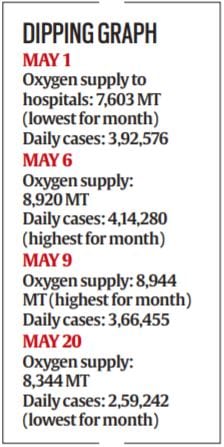Early signs of the waning of the oxygen crisis are visible in the country with liquid medical oxygen supplied to hospitals over the last 72 hours showing a decline for the first time in almost a month.
“Actual consumption has dropped to 8,000 MT a day from around 8,900 MT a day,” an official said. While the quantity supplied has dropped, it is still much higher than the demand recorded during the first wave of Covid-19 last year.

The data maintained by an empowered group of officers tasked with oxygen supply shows total oxygen supplied to hospitals hit a peak of 8,944 metric tonnes (MT) per day on May 9 dropped to about 8,100 MT a day on May 18-19. However, it has again risen marginally to 8,334 MT a day on May 20.

Total oxygen includes liquid oxygen supplied in bulk by manufacturers and refillers and cylinders supplied by refillers to the hospitals.
During the first wave, the maximum sale of LMO – 3,095 MT a day – was seen on September 29, 2020. Since then, it followed a downward trend. In fact, the sale of LMO was only 1,559 MT a day on March 31 this year.
However, when cases started rising, the demand for LMO increased manifold in the following weeks. It crossed the 8,000 MT per day mark on April 30 and continued to rise further in the first week of May. It was in the first week of May that the country recorded the highest number of daily cases – 4.14 lakh – on May 6.
After reaching its peak on May 9, the supply of LMO to hospitals registered a steady decline and came down to 8,394 MT on May 14. But it again rose to over 8,900 MT on May 17. However, on May 18-19, the supply of LMO to hospitals remained flat at around 8,100 metric tonnes.

Story continues below this ad
Significantly, the supply of oxygen to hospitals is still hovering around 8,000 MT a day, while the number of daily new cases have dropped below three lakh.
According to government data of May 8, nearly 50,000 Covid patients were in intensive care units, more than 14,500 on ventilator support, and over 1.37 lakh patients on oxygen support.
This is much higher than the figure reported during the first wave in September, when about 23,000 patients were in ICUs, less than 4,000 on ventilators, and around 40,000 required oxygen support.
The number of states and Union Territories demanding LMO has increased from 12 on April 15 to 33 on May 8. The states witnessing a higher demand for oxygen are Delhi, Maharashtra, Karnataka, Uttar Pradesh and Gujarat.











